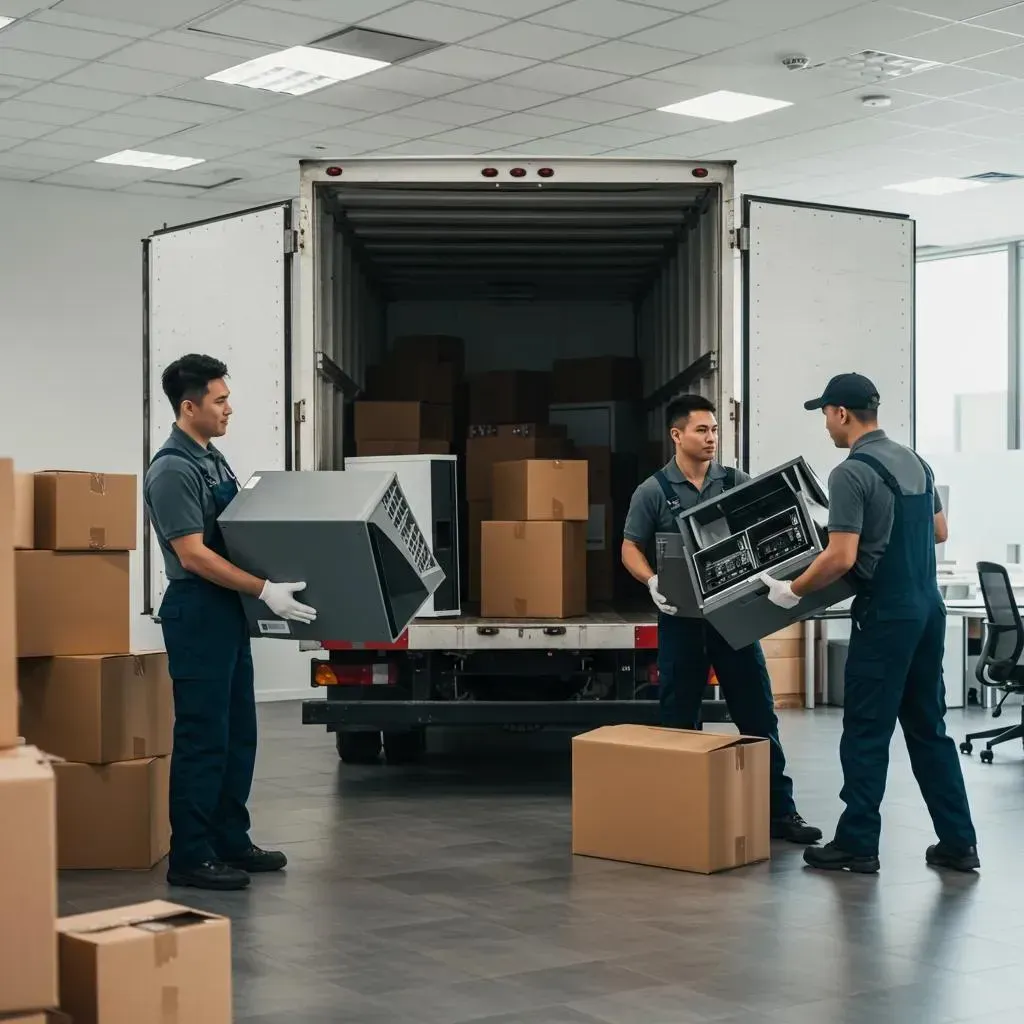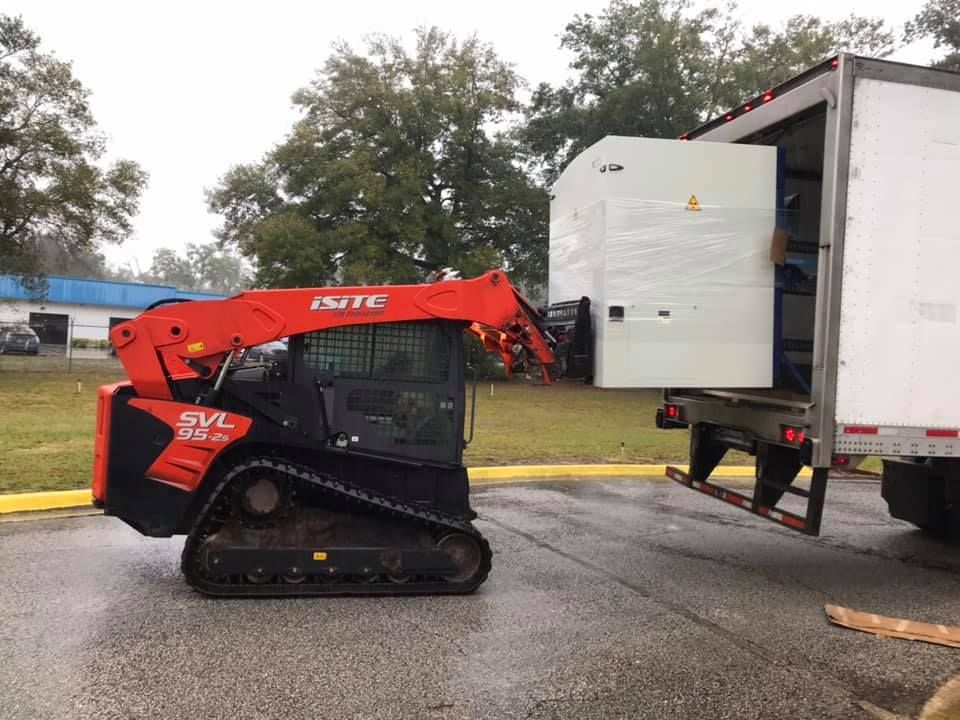BLOG
We Earned Their TRUST...
Now, Let Us Earn Yours!
Full-Service vs. DIY Business Moves: What's Best for Your Company?

When it's time to move your business, you'll need to decide between hiring a full-service moving company or tackling the job yourself. This article breaks down what each option entails, how they work, and the key factors—like cost, time, liability, and handling special equipment—that will help you make the right choice for your company. You'll learn about the complete services offered by full-service movers, the typical tasks and potential hidden costs of a DIY move, and guidance to help you pick the best approach for your organization. We'll compare the two options side-by-side, look at what drives costs, and provide practical checklists to help you weigh the pros and cons and plan effectively. We'll also reference MOVE IT ALL / Full Service Mover, a local Orlando company, to illustrate how commercial movers package their services like Commercial Moving and Full-Service Moving. Our goal is to equip you to estimate the impact on your business operations, budget, and asset protection, and to know when to get a professional estimate.
What Exactly Is Full-Service Business Moving?
Full-service business moving means a professional moving company manages your entire relocation from start to finish, handling all the planning, packing, moving, and setup to keep your operations running smoothly. They achieve this by using trained teams, specialized equipment, and expert coordination to move your belongings safely and efficiently, ensuring a faster and more predictable outcome. The biggest advantage is minimizing downtime and transferring most of the moving risks to the professionals through insurance and established procedures. Here, we'll detail the services typically included, how they handle sensitive equipment, and why guaranteed pricing and experienced crews are crucial when keeping your business up and running and your assets secure. We'll then show you how a commercial provider like MOVE IT ALL handles these services.
What Services Are Included in Full-Service Commercial Moving?

Full-service commercial moving typically covers every aspect of your relocation, taking the burden off your shoulders and ensuring your new workspace is ready to go. This usually includes packing everything from desks to files, carefully crating fragile items, professional loading and secure transport, unloading at your new location, unpacking, reassembling furniture, and placing everything exactly where you need it. Professional movers often also provide project management, coordinate with building management, and stage your new office so you can get back to business quickly. These services are designed to minimize downtime and free up your staff from logistical tasks, which is especially important for complex office or medical facility moves.
Here’s what you can typically expect:
- Packing and Crating: We pack up your desks, files, and delicate equipment.
- Loading and Transport: Our trained teams use secure vehicles for safe transit.
- Unpacking and Setup: We reassemble furniture and set up your systems.
With these services covered, let's look at how professionals safeguard your sensitive office equipment during transit.
How Do Professional Movers Handle Specialized Office Equipment?
Moving sensitive items like servers, medical devices, or large office systems requires specific procedures to ensure they arrive in perfect working order. Movers use asset tagging, specialized climate-controlled packaging, custom crating, and appropriate lifting equipment. They often work with your IT or clinical staff to document configurations and shutdown processes before the move. Our trained crews follow detailed checklists for disconnection, secure transport with shock monitoring, and careful reinstallation to minimize the risk of failure and keep your operations running smoothly. These precautions help prevent costly replacements and business interruptions, and ensure a clear process for any necessary insurance claims.
This careful handling naturally leads to why guaranteed pricing and experienced crews are so important for predictable results during complex moves.
What Are the Benefits of Guaranteed Pricing and Professional Expertise?
Guaranteed pricing and professionally trained crews mean predictable budgets and fewer unexpected issues that can derail your move schedule or inflate costs. With a fixed or clearly defined price, you can confidently budget for your relocation without worrying about fluctuating labor costs or surprise fees. Skilled movers work faster and safer, reducing the risk of damage to your assets and injuries to staff. Documented processes also make handling any necessary claims much smoother. Together, these elements protect your budget and ensure business continuity—the core goal of full-service business moving.
Understanding the scope of full-service moving helps us contrast it with the process and trade-offs of self-service moves, which we'll cover next.
What Is Self-Service Business Moving and How Does It Work?
Self-service business moving means you handle most of the tasks yourself—packing, loading, and arranging transport—often hiring only specific labor or renting equipment to cut down on direct moving company fees. This approach shifts the responsibility for labor, coordination, and risk to your business, requiring you to manage inventory, schedule vehicle rentals, and oversee temporary staff. The main appeal is the apparent cost savings on vendor fees, but the trade-offs include using more of your internal resources, longer timelines, and a higher risk of hidden costs and damage. Below, we'll list the common DIY tasks, explore the perceived savings versus hidden risks, and estimate the staff time and effort needed to successfully complete a self-service move.
What Are the Typical DIY Tasks in a Self-Service Business Move?
A self-service move requires you to plan and execute a series of tasks that professionals usually handle, from initial inventory to final setup at your new location. This typically involves creating a detailed inventory and labeling system, buying packing supplies and pallets, packing and crating fragile items, renting trucks and managing driving logistics, coordinating temporary labor or volunteers for loading and unloading, and reinstalling furniture and systems. Each task demands time, coordination, and specific materials, and mistakes at any stage can lead to delays or damage. Understanding this task list is crucial for realistic cost and timeline planning when considering a DIY approach.
Your core DIY responsibilities include:
- Inventory & Labeling: Create asset lists and identification for the move.
- Packing & Crating: Source materials and carefully pack items.
- Transport Coordination: Rent vehicles and manage all driving logistics.
Accurately accounting for these tasks leads directly to understanding the perceived savings and often overlooked costs of self-service moves.
What Are the Perceived Cost Savings and Hidden Risks?
Businesses often opt for self-service expecting lower upfront costs, but hidden expenses like rental insurance, fuel, overtime, asset damage, and extended downtime can quickly erode or even exceed those savings. Perceived savings usually come from avoiding vendor labor charges and choosing cheaper rentals. However, the risks include less protection for high-value equipment, incomplete liability coverage, and lost productivity as your staff manages the move. A quick calculation comparing estimated rental and labor costs plus expected downtime often reveals that if downtime is costly, full-service options might actually be more economical. Recognizing these hidden costs helps you weigh true savings against operational risks.
This cost-risk analysis naturally leads us to estimating the effort and time required to execute a self-service move.
How Much Effort and Time Does a Self-Service Move Require?
A self-service relocation demands significant internal coordination and staff hours, with the effort scaling up based on your business size and the complexity of your assets. Small office moves might be manageable over a weekend with a few employees or contractors, but medium to large moves often require dedicated internal project managers, multiple teams working over several days, and complex scheduling to avoid disrupting daily operations. You should estimate the time needed for each task—packing, loading, transport, unpacking, and setup—and multiply that by your staff's availability, carefully considering peak business hours to prevent service interruptions. Clear timelines and contingency plans are essential for a DIY move, as underestimating the effort involved is a common reason for project failure.
Understanding the effort and time trade-offs helps inform a side-by-side comparison of both options, which we detail in the next section.
What Are the Key Differences Between Full-Service and Self-Service Business Moves?
Full-service and self-service moving differ significantly in their cost structure, time to completion, risk allocation, internal effort required, and how specialized equipment is handled. The main distinction is that full-service providers offer project-managed solutions with trained crews and predictable pricing, while self-service relies on your internal resources and variable third-party rentals, shifting risk and coordination overhead to your business. Each approach leads to different operational outcomes: full-service typically minimizes downtime and asset risk, while self-service can reduce vendor fees but increase internal labor costs and potential hidden expenses. The following table summarizes these differences across core attributes to help you quickly compare them before we explore the detailed implications.
| Move Option | Attribute | Typical Outcome |
|---|---|---|
| Full-Service | Cost | Higher vendor fees but predictable and often all-inclusive |
| Self-Service | Cost | Lower visible fees but variable hidden expenses and rental costs |
| Full-Service | Time | Faster execution with project management and trained crews |
| Self-Service | Time | Longer timelines dependent on internal availability |
| Full-Service | Risk | Lower asset and liability exposure with insurance and protocols |
| Self-Service | Risk | Higher exposure to damage and downtime without professional safeguards |
How Do Cost Implications Compare Between Full-Service and Self-Service Moves?
Cost differences stem from labor models, materials and equipment, insurance, distance, and the complexity of your assets. Full-service pricing bundles these into a single estimate, while self-service separates line items. Full-service providers charge for planning, trained labor, specialized packing, secure transport, and setup—costs that can be offset by reduced downtime and lower damage risk. Self-service expenses include truck rental, fuel, packing supplies, temporary staff, and potential overtime or replacement costs if damage occurs. You should compare the total cost of ownership by including potential downtime losses and replacement risks, not just vendor fees.
| Cost Driver | Description | Example Value/Estimate |
|---|---|---|
| Labor | Trained crew hours vs. internal staff time | Professional crew hourly rate vs. multiple staff days |
| Materials | Packing, crating, specialty materials | Custom crating for servers increases material costs |
| Equipment | Lifts, dollies, transport vehicles | Rental fees vs. specialized gear included in full-service |
| Insurance | Coverage for transit and liability | Full-service often includes higher transit coverage |
| Downtime | Lost revenue or productivity during the move | Can exceed vendor fees for time-sensitive businesses |
How Does Time and Efficiency Differ in Each Moving Option?
Full-service moves leverage project management, scheduling expertise, and experienced crews to shorten timelines and coordinate tasks simultaneously, leading to faster overall completion. In contrast, self-service moves require sequential task execution by internal teams, which typically extends timelines, increases coordination complexity, and risks operational overlap that prolongs downtime. The efficiency gains from full-service often justify the higher upfront fees for companies where getting back to operations quickly is critical. Recognizing these timing differences is essential for businesses that must plan around service windows or customer-facing operations.
What Are the Risk and Liability Considerations for Each Option?
Risk and liability vary because full-service movers usually carry specialized insurance, have documented handling protocols, and employ trained crews, all of which reduce claims and safety incidents. Self-service moves, however, expose businesses to limited rental insurance and internal liability for employee injuries. Full-service contracts typically specify responsibilities for claims and coverages for in-transit damage, while self-service scenarios require businesses to secure appropriate rental coverage and accept potential gaps. To minimize risks in either model, businesses should verify insurance limits, document asset conditions before moving, and implement safety protocols for internal staff.
How Do Required Effort and Resources Vary?
Resource demands differ sharply: full-service shifts the operational burden to the provider, requiring minimal internal oversight, whereas self-service demands dedicated internal project managers, sufficient labor for packing and staging, and expertise for handling sensitive equipment. Full-service engagements reduce the need for internal capital investment in equipment and allow staff to focus on business continuity, while self-service may require purchasing or renting specialized gear and allocating significant employee hours. Businesses must assess their internal capabilities and decide whether to commit resources or outsource for predictable performance.
How Is Specialized Equipment Handling Managed Differently?
Specialized handling in full-service moves relies on trained crews, calibrated packing materials, and tested transport methods to preserve the integrity of servers, medical devices, and calibrated instruments. Self-service approaches often lack the technical procedures and protective gear needed for such items. When equipment requires specific shutdown sequences, environmental controls, or precision reinstallation, professional movers coordinate with technical staff to document configurations, transport under monitored conditions, and assist with reassembly and testing. Hiring specialists for these assets reduces functional risk and speeds up post-move validation.
When Should Businesses Choose Full-Service vs. Self-Service Moving?
The choice between full-service and self-service moving depends on your business priorities, such as time sensitivity, asset value, complexity, budget flexibility, and your internal capacity to manage logistics. Full-service is recommended when minimizing downtime, protecting sensitive equipment, or managing large-scale consolidations are top priorities. Self-service may be suitable for small, simple relocations with flexible timelines and limited high-value assets. Below, we map typical business scenarios to recommended options to help you decide, followed by a concise checklist to guide your choice.
| Business Scenario | Recommended Option | Rationale |
|---|---|---|
| Medical office relocation | Full-Service Commercial Moving | Protects specialized devices and minimizes clinical downtime |
| Small branch move with limited assets | Self-Service | Lower cost and manageable by internal staff |
| Enterprise consolidation | Full-Service | Requires project management and staging to minimize downtime |
What Are Ideal Scenarios for Choosing Full-Service Business Moving?
Full-service moving is ideal for time-sensitive relocations, moves involving high-value or sensitive equipment, complex reconfigurations, and projects where internal staff cannot afford to be diverted to logistics for extended periods. Situations like medical office relocations, server room transfers, or multi-floor corporate consolidations benefit greatly from project-managed services that include packing, specialized handling, and staged installation. Full-service reduces coordination errors and provides predictable timelines essential for maintaining client and patient operations. Organizations facing potentially high downtime costs should strongly consider full-service to protect revenue and reputation.
When Is Self-Service Moving a Suitable Option?
Self-service is suitable when moves are small in scale, involve mostly non-sensitive furniture or supplies, your internal staff are available and capable of handling logistics, and your timeline is flexible enough to accommodate slower progress. Examples include relocating a small sales office to a nearby suite or moving noncritical storage areas where downtime has minimal impact and cost control is paramount. Businesses choosing self-service should be prepared for increased risk, plan conservatively for extra time, and purchase appropriate rental insurance to cover potential damage. Evaluating these conditions helps determine if a DIY move aligns with your organization's tolerance for disruption and risk.
Why Is MOVE IT ALL the Preferred Full-Service Commercial Moving Partner in Orlando?
MOVE IT ALL / Full Service Mover stands out as a local Orlando partner offering comprehensive full-service commercial solutions designed to minimize business disruption. The company emphasizes guaranteed pricing with no surprises, skilled journeyman movers, and a service scope that includes packing, disassembly/reassembly, and handling of large and sensitive items—all crucial for commercial relocations. MOVE IT ALL lists its regulatory credentials (USDOT #3810487, MC #1374983, IM #3596), operates in Orlando, Florida from 40 N. Alder Drive, Orlando, FL 32807, and provides a dedicated Commercial Moving service focused on reducing downtime for businesses. These credentials and service focuses form the foundation of their commercial offering and support lead generation for larger projects.
What Unique Value Does MOVE IT ALL Offer for Business Relocations?
MOVE IT ALL highlights several differentiators that matter to commercial clients: guaranteed pricing to limit budget variability, professional journeyman movers to speed up execution, and comprehensive services including packing and specialized handling. These features help clients plan relocation costs and operational impacts with greater confidence, as predictable pricing and trained crews reduce the likelihood of cost overruns and asset damage. By offering full-service packages tailored to business needs, MOVE IT ALL addresses common pain points, especially for organizations that require minimal downtime and reliable handling of complex equipment.
How Does MOVE IT ALL Minimize Downtime and Protect Business Assets?
MOVE IT ALL reduces interruption through project-managed timelines, on-site coordination, and staging practices that allow for phased transitions and off-hours work when necessary to keep facilities operational. Their crews use industry-standard packing methods and handle large items with appropriate equipment, which together decrease the chance of damage and expedite reassembly at the destination. These approaches are particularly important for enterprises and medical practices where prolonged downtime has substantial cost implications. For businesses evaluating options, this operational focus translates into measurable improvements in move speed and reduced post-move recovery efforts.
What Do Orlando Businesses Say About MOVE IT ALL's Commercial Moving Services?
Orlando clients consistently highlight efficient execution and clear pricing as deciding factors when choosing a commercial mover, and MOVE IT ALL's focus on guaranteed prices and skilled crews aligns perfectly with those priorities. Reported outcomes often include minimized downtime, careful handling of sensitive equipment, and reliable scheduling that respects business hours and operational constraints. These client experiences demonstrate how a full-service commercial approach can reduce stress and accelerate a return to business-as-usual. These endorsements underscore the practical value of selecting a mover experienced with business relocations over a generalist or DIY approach.
How Much Does Full-Service Commercial Moving Cost Compared to Self-Service?
Costs depend on labor, materials, equipment, distance, insurance, and the complexity of assets being moved. Full-service pricing bundles these factors, while self-service spreads them across rentals, internal labor, and potential hidden expenses. The main cost drivers are labor hours for packing and handling, specialized packing and crating, transportation distance and vehicle size, insurance and declared value, and any required specialty services like server relocation or medical equipment handling. Below is a practical cost-driver table showing example estimates and how businesses can approach transparent pricing through on-site assessment options offered by commercial providers.
| Cost Driver | Description | Example Impact |
|---|---|---|
| Labor | Hours of trained movers vs internal staff time | Major line item for full-service moves |
| Materials | Boxes, crates, protective wrap, pallets | Custom crating increases cost for sensitive assets |
| Transportation | Vehicle type and distance | Long-distance adds to fuel and driver time |
| Insurance | Transit and liability coverage | Higher declared values increase premiums |
| Specialty Handling | Server moves, medical gear, disassembly | Requires extra equipment and expertise |
Accounting for these drivers helps businesses build a realistic moving budget and compare models.
What Factors Influence Full-Service Moving Pricing?
Full-service pricing varies based on projected labor hours, the number and complexity of items, required specialized equipment, insurance levels, and logistical challenges like stair carries or limited access. Providers may offer guaranteed pricing models to cap variability or hourly/line-item pricing that reflects actual resources deployed. Businesses should ask what is included—packing materials, disassembly/reassembly, surge protection for electronics, and post-move cleanup—to avoid surprise charges. Clear scopes and on-site assessments reduce ambiguity and lead to more accurate fixed-price proposals that align with operational objectives.
These pricing factor explanations lead into how businesses can estimate self-service costs for a fair comparison.
How Can Businesses Estimate Self-Service Moving Costs?
Estimating self-service costs requires itemizing truck rental fees, fuel, packing materials, hired labor, potential overtime, and a conservative allowance for downtime and incidental repairs. A short sample calculation for a small office might include a one-day truck rental, two staff days for packing and loading, and material costs. For a medium move, add multi-day rentals, third-party labor, and possible replacement costs for damaged items. Including a contingency line—often 10-25% of estimated direct costs—for hidden expenses and downtime helps create a safer budget. This disciplined approach yields clearer comparisons against full-service quotes.
Next, we provide example pricing scenarios that illustrate the trade-offs between the two models.
Are There Example Pricing Scenarios for Both Moving Options?
Example scenarios help illustrate how choices affect cost, time, and risk outcomes. A small office move might show modest savings with self-service but limited risk exposure, while a medical office or enterprise consolidation will often favor full-service due to high disruption costs. Scenario comparisons typically present estimated direct costs, projected downtime, and risk-adjusted replacement exposure to demonstrate that full-service can be more cost-effective when downtime or replacement costs are significant. These examples support data-driven decisions and highlight the importance of obtaining an on-site estimate for accurate commercial pricing.
What Are the Common Questions About Full-Service vs. Self-Service Business Moves?
Businesses frequently ask how the two models differ in practice, whether full-service is worth the cost, what full-service includes, the downsides of self-service, and how to request professional quotes. Concise answers to these questions simplify decision-making. The following Q&A provides direct comparisons, ROI framing for full-service, a succinct checklist of included full-service deliverables, and guidance for requesting accurate estimates from commercial movers like MOVE IT ALL. These answers aim to address typical procurement and operational concerns so managers can move forward with confidence.
What Is the Difference Between Full-Service and Self-Service Moving?
Full-service moving delegates planning, packing, transport, and setup to a professional provider, using trained crews and specialized equipment to minimize downtime and protect assets. Self-service places those responsibilities on your business, requiring internal staff to manage logistics, rent equipment, and accept greater operational risk. The trade-offs are primarily between predictable, higher upfront vendor costs and apparent savings plus internal resource allocation when doing it yourself. Choosing between them means comparing the total cost of ownership—including downtime and risk exposure—rather than just vendor fees.
- Responsibility: Provider-managed vs. client-managed.
- Risk: Professional insurance and protocols vs. internal exposure.
- Time: Faster execution with full-service vs. longer DIY timelines.
These contrasts help determine if full-service justifies its cost given your business's operational priorities.
Is Full-Service Moving Worth the Cost for Businesses?
Full-service is worth the cost when downtime, asset value, and complexity create high risk, or when internal resources are insufficient to manage a smooth relocation. The ROI favors full-service if the cost of interrupted operations, lost productivity, or damaged equipment exceeds the premium paid for professional services. For businesses with mission-critical systems or patient-facing services, the predictability and reduced recovery time often outweigh initial cost differences. Evaluating potential downtime costs alongside vendor quotes clarifies the ROI for full-service moving.
What Does Full-Service Commercial Moving Include?
Full-service commercial moving typically includes comprehensive logistics: thorough pre-move planning, packing and crating of assets, secure loading and transportation, unloading, unpacking, reassembly of furniture and fixtures, and project coordination until the new location is operational. These services remove most manual tasks from internal teams and provide documented procedures for handling, insurance, and claims. The comprehensive scope supports faster reactivation of business functions and reduces the cycle time for resuming normal operations.
- Pre-move planning and scheduling
- Packing, transport, unpacking
- Disassembly/reassembly and staging
Knowing these deliverables helps businesses accurately evaluate vendor proposals.
What Are the Disadvantages of Self-Service Business Moves?
Self-service moves expose businesses to increased risk of damage, limited insurance coverage, longer timelines, and significant internal labor diversion. These downsides can translate into hidden costs that offset initial savings. Additional disadvantages include the need to source specialized packing materials, coordinate multiple vendors, and manage safety risks without professional procedures. To mitigate these issues, organizations should document asset conditions, purchase supplemental insurance, and factor in generous contingency time for project plans.
Understanding these disadvantages prepares decision-makers to choose an appropriate moving model or to augment self-service with selective professional support.
How Can Businesses Request a Quote for Full-Service Moving?
To request an accurate full-service quote, provide a mover with an inventory of items, details on specialized equipment, information about site access at both locations (including elevators, stair carries), and your preferred move dates. This information enables precise scoping and transparent pricing. MOVE IT ALL offers Free On-Site Estimates for Larger Businesses and a Commercial Moving service that includes tailored solutions like packing, transportation, unpacking, setup, and specialized handling of items such as medical equipment and cubicles. Sharing documentation and scheduling preferences upfront helps vendors provide guaranteed pricing and scopes that align with your organization's downtime goals.
Here’s recommended information to provide for quotes:
- Complete inventory and photos of key assets
- Site access details and move timing constraints
- List of any specialized handling requirements
These steps improve estimate accuracy and reduce negotiation cycles when selecting a commercial mover.
Frequently Asked Questions
What are the main factors to consider when choosing between full-service and self-service moving?
When deciding between full-service and self-service moving, consider factors such as the complexity of the move, the value of the assets being relocated, the timeline for the move, and your budget. Full-service moving is ideal for complex relocations involving sensitive equipment or when minimizing downtime is critical. In contrast, self-service may be suitable for simpler moves where cost savings are prioritized, but it requires more internal resources and can lead to hidden costs if not managed carefully.
How can businesses prepare for a self-service move to minimize risks?
To prepare for a self-service move and minimize risks, businesses should create a detailed inventory of items, procure adequate packing materials, and establish a clear timeline for each task. It's also essential to train staff on proper packing and handling techniques, especially for sensitive equipment. Additionally, securing appropriate rental insurance and allowing for contingency time in the schedule can help mitigate potential issues such as damage or delays during the move.
What types of businesses benefit most from full-service moving?
Businesses that benefit most from full-service moving typically include those with high-value or sensitive equipment, such as medical offices, tech companies, and large enterprises undergoing consolidation. These organizations often face significant downtime costs and require specialized handling to ensure operational continuity. Full-service moving provides the expertise and resources needed to manage complex logistics, making it a preferred choice for businesses that cannot afford disruptions during relocation.
Are there specific scenarios where self-service moving is not recommended?
Self-service moving is not recommended in scenarios involving high-value assets, complex equipment, or when time is of the essence. For example, medical facilities that rely on specialized equipment should avoid self-service due to the risk of damage and the need for precise handling. Additionally, businesses with limited internal resources or expertise may find that self-service leads to increased stress and potential operational disruptions, making full-service a more viable option.
How can businesses assess the total cost of ownership for each moving option?
To assess the total cost of ownership for full-service versus self-service moving, businesses should consider not only the direct costs of moving services but also potential hidden costs such as downtime, equipment damage, and employee labor hours. Creating a comprehensive budget that includes all these factors will provide a clearer picture of the financial implications of each option. This analysis helps in making an informed decision that aligns with the organization's operational priorities and budget constraints.
What role does insurance play in full-service versus self-service moving?
Insurance plays a crucial role in both full-service and self-service moving, but the coverage levels differ significantly. Full-service movers typically provide comprehensive insurance that covers transit and liability, reducing the risk for businesses. In contrast, self-service moving often relies on limited rental insurance, which may not fully protect against damage or loss. Businesses should carefully evaluate their insurance options and consider purchasing additional coverage when opting for self-service to mitigate potential risks.
Conclusion
Choosing between full-service and self-service business moving options can significantly impact your operational efficiency and cost management. Full-service moving minimizes downtime and risk through professional handling and guaranteed pricing, making it ideal for complex relocations. In contrast, self-service may offer initial savings but often leads to hidden costs and increased internal resource demands. Evaluate your specific needs and explore our services to find the best moving solution for your business today.













